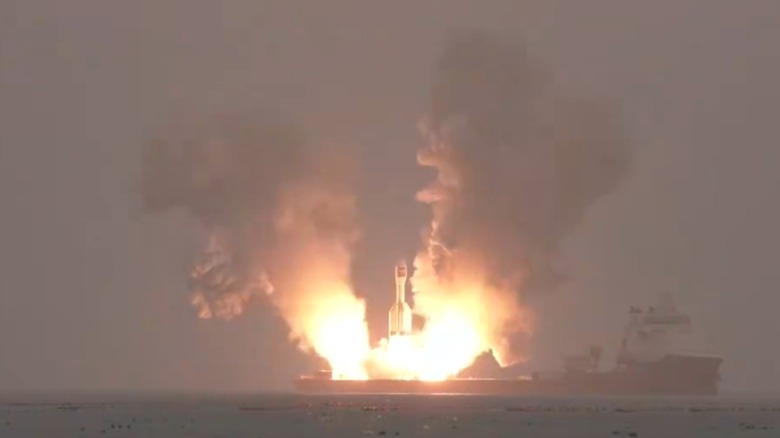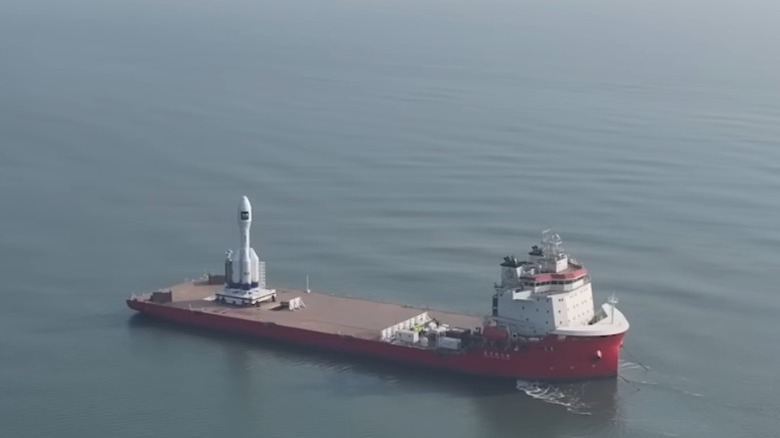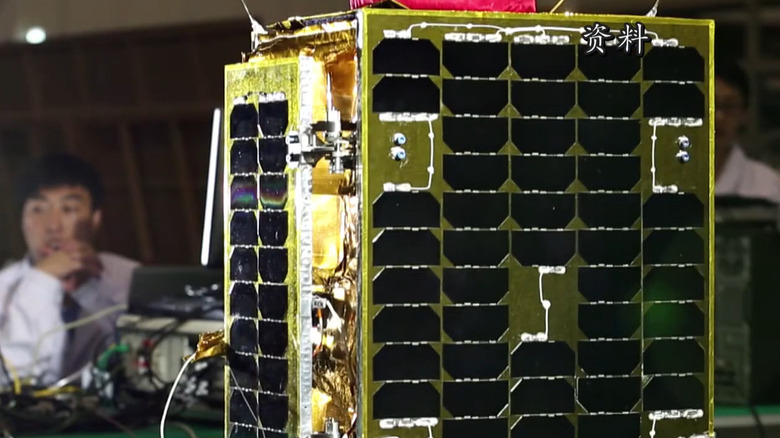The World's Biggest Solid-Propellant Rocket Has Successfully Launched For A Second Time
A private Chinese firm has successfully launched the world's largest solid-propellant rocket for a second time. The company, Orienspace, launched the gigantic 30-meter Gravity-1 rocket from a barge in the Yellow Sea on October 10, 2025. This follows on from the first Gravity-1 rocket launch, which happened in January 2024 at the same location.
What makes Gravity-1 notable is its sheer size. The rocket consists of an all-solid stack with three core stages and four side boosters. The rocket can generate a take-off thrust of 600 tons, with a lift-off mass of 400 tons. Orienspace advertises a cargo capability of 6.5 tons into low-earth orbit or 4.2 tons for a sun-synchronous orbit 500 km (310.6 miles) above Earth. For this launch, the Gravity-1 carried three satellites as payload. These were the Jilin-1, the Shutian Yuxing-1, and the Shutian Yuxing-2.
According to Orienspace, the October Y2 mission was intended to validate pre-launch procedures, trajectory handling, and rapid-response readiness. The latter point is important to Orienspace, as it has repeatedly highlighted the rocket's short-launch capability as a selling point. The relative simplicity of solid-rocket boosters helps here, especially when compared to more complex liquid-fueled rockets like SpaceX's massive Starship. The latter, despite recently marking a major test program milestone, has a checkered history with multiple failures.
From startup to spaceflight in four years
Founded in June 2020, Orienspace is one of a growing number of Chinese firms reaching for the stars (or, at least, Earth orbit). The Gravity-1, or Yinli-1 as it's known domestically, is the company's first rocket. The development of the rocket has been incredibly quick, with the first launch taking place in January 2024, a mere four years after the company was formed. Part of this development speed can be attributed to the company's decision to use solid-fueled rockets, which are simpler than their liquid-fueled counterparts.
The fuel pumps and lines required by liquid-propellant rockets make them heavier and more complex. Solid-propellant rockets are much simpler, requiring an insulated case, propellant, a nozzle, and an ignitor. The concept isn't dissimilar to that of fireworks, although there are downsides to this simplicity. The main weakness is that there's little control over the combustion process; once the propellant is ignited, it can't be shut down, nor is there any way to regulate thrust.
The 70-meter, 21.5-ton payload Gravity-2 rocket being developed by the company is a more advanced liquid-fueled rocket. With the engines already having completed a static fire test earlier this year, Orienspace hopes to complete its first test flight in 2025. The company is also working on a Gravity-3 rocket, a larger variant of the Gravity-2, which the company states will be able to carry a 61-ton payload into orbit.
Small payload, big picture
The Gravity-1's second mission may have been slated as a test flight, but it did carry three satellites into low-earth orbit. The most notable is the Jilin-1, an earth observation satellite for Changguang Satellite Technology that can supply imagery with a resolution of 0.5 meters over a 150-kilometer field of view. The other two satellites, the Shutian Yuxing-1 and Shutian Yuxing-2, were developed by Geespace, Chinese automaker Geely's aerospace arm.
While this might seem modest in scale — SpaceX launched more than double the satellites of the entire Chinese space industry in 2024 — it's representative of China's growing ambition to launch tens of thousands of satellites to create a massive web of interconnected constellations for data, imagery, and communications. Among them is a system aiming to compete with SpaceX's Starlink. All adding to the growing number of satellites orbiting the earth.
Dozens of Chinese private space companies, including Orienspace, are hoping to increase China's capabilities to match the country's launch requirements. Many of these designs focus on reusable first-stage boosters. While Gravity-1 is certainly a part of the bigger strategic picture to launch thousands of satellites, the company also emphasizes the rocket's flexibility. According to Orienspace co-founder Peng Haomin, the rocket can be made ready to launch remarkably quickly, with the company capable of launching a rocket within 24 hours if needed.


